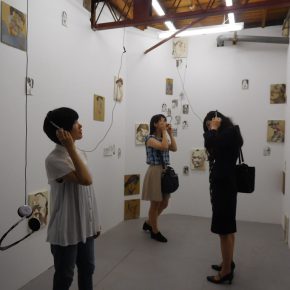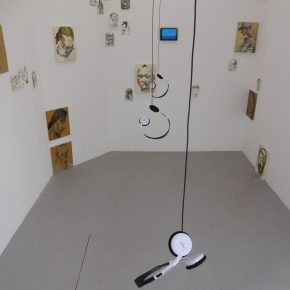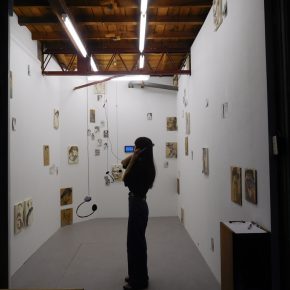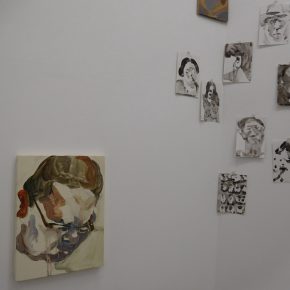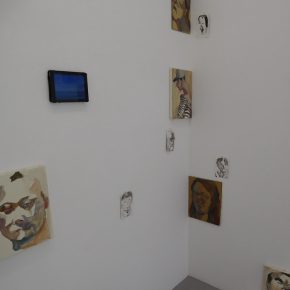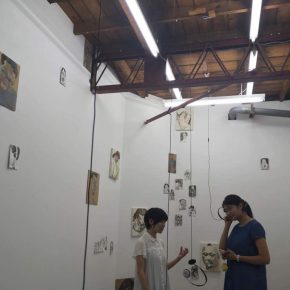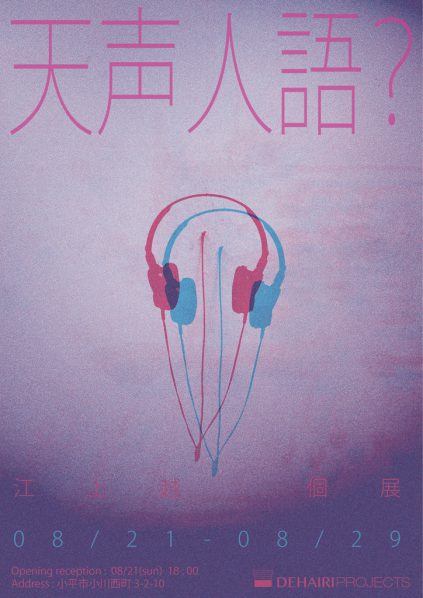
Artist Statement
As human beings are social animals, language is the most effective means of communication.
Language is human instinct, and it is the will of God, and also "God’s voice” is “the language of the people”. However, language is not only a tool of communication, but it also might construct communication barriers. In the real what is the "voice" ? Can people really tell that exactly?
If the false of the making the tower of Babel in the Old Testament was because of the misunderstanding in languages, mishearing of the words distorted in many conflicts and might be unhappy. These results are also unhappy, which might be to some extent hard to get rid of the spiral.
From the origin of the world, I want to search a human instinct and re-think the society by words.
Curator Statement
Egami Etsu continues the important topic of her works in the exhibition: "misreading". And this exhibition at her home country: Japan, this familiar land, she tried to increase on the existence of the misreading vocabulary in local context , to increase dimensions in the context of her creation .
“Tensei Jingo (means God’s voice, human’s words)”, came from the social editorial plate of "Asahi News Paper", the Japanese mainstream newspaper . This perfect grammar and social problems that span "Asahi News Paper" became benchmark reference of learning Japanese not only for foreigner but also for Japanese. In this exhibition, Metaphor representation under the “Tensei Jingo (means God’s voice, human’s words)” , Egami Etsu investigates a language of signifier and signified and a lot of trouble and interest in different context of "Misreading". To reflect on the problems of globalization to their her creation.
Gao Jiangbo (Curator)
About EGAMI ETSU
江上越 / EGAMI ETSU
Born in Japan
2016 Graduated from Central Academy of Fine Arts, BFA in the 3rd oil painting class, Bachelor
2016-Present Postgraduate Study in Central Academy of Fine Arts, supervised by Liu Xiaodong
Lives and works in Beijing and Japan
The article reportsArt Beijing 2013, 2014, 2015
The Second China Sculpture Exhibition
Li Shutong Exhibition in the Central Academy of Fine Arts Museum (Tokyo University of the Arts and Central Academy of Fine Arts )
Publication article2013 GekkanBijyutu issue 06 "More Success of Asian Contemporary Art Exhibition, Japan, China and Korea"
2014 GekkanBijyutu issue 07 article "Expected the new art based on tradition, Reflects the trend of Chinese art market "
2015 GekkanBijyutu issue 07 article "A design section is added and 10 lap year exhibition expands to three sections", the Central Academy of Fine Art News Paper 132
Exhibitions2016 "Neither Here Nor there", Yuan Dian Art Museum
"Yu China Blue" collaboration, Yuan Dian Art Museum
"Fan Xin Ji Hua", Tree Art Museum, Beijing /Tian Jin Wen Hua Gu, Tianjin/Comunication Artmuseum Between China and Japan, Tokyo/Miami USA
Graduate exhibition, CAFAM
“God’s voice, human’s words?” DEHAIRI projects, TOKYO Japan
“God’s voice, human’s words?” Vacumm space, BEIJING China
“It is not the mislistening game” de Sarthe gallery, BEIJING
2015 Yunnan Sketch exhibition
Workshop with Henk Visch exhibition, CAFA
The 16th East International Art Exhibition, Japan
Selected in The 3th China International Forum for Art Installation, Beijing
2014 Youth exhibition, CAFA
Qinghai Sketch Exhibition, CAFA
The 12th National Art Exhibition, Liang He Art Museum
The 15th East International Art Exhibition, Japan
2013 Youth Exhibition, CAFA
Winter Creation Exhibition, CAFA
Beijing Sketch Exhibition, CAFA
The 14th East International Art Exhibition, Japan
2012 The 13th East International Art Exhibition, Japan
Public CollectionCentral academy of fine art Art museum (CAFAM), Tree Art Museum and Yuan Art Museum
About DEHAIIRI projects
As contemporary art projects space in Tokyo JAPAN, Dehairi is a non-profit art project which maintains its own exhibition space. Dehairi means “come in and go out" in Japanese. The space is located in an art district of Kodaira-shi, Tokyo and is situated between the artists' village.
Courtesy of the artist and DEHAIIRI projects.


